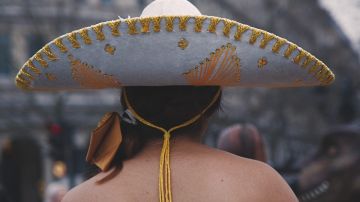25 Fashion Pieces With Latinx or Hispanic Origins
Every day, we put on clothes without really thinking about where these individual pieces come from historically

Photo: Unsplash/@grievek1610begur
Every day, we put on clothes without really thinking about where these individual pieces come from historically. After decades, sometimes centuries, certain garments and accessories just get absorbed into American/mainstream culture and their roots often go with them. This is when some good fashion history research needs to be done and shared.
There are so many pieces of clothing and accessories that millions buy and wear (and that you probably own) that come from Latin America and Spain (or both). And this provenance isn’t pointed out or celebrated as much as it should be. We should know about them, and so should the rest of the world. So, we are sharing 25 style pieces that we should definitely take credit for.
wp_*posts
Poncho
One garment you may know that is Latin American in origin is the poncho. The Indigenous people of what is now Peru, Ecuador, Bolivia, and Chile were wearing these outer garments, made from one piece of fabric with a hole for the head before Spanish contact. Since then, several different options have emerged, in all sorts of colors, patterns, and styles.
wp_*posts
Panama Hat
https://www.instagram.com/p/BzttgQDFdEB/
So we know that the Panama hat is Latinx in origin, but there’s a catch. Although it is named after the Central American country of Panama, the straw and woven brimmed hat is from Ecuador. During the 1830s, Spaniard Manuel Alfaro set up a business there; his hats were then exported to the Gulf of Panama. It was here where those headed for the Gold Rush would grab Panama hats for protection from the sun.
wp_*posts
Huaraches
Huaraches have been copied for ages, and even Nike has named some sneakers after the footwear of Tarahumara runners as inspiration for their shoes. But their origin is right in Guanajuato, Michoacan, Yucatan, and Jalisco, Mexico. In fact, the word “kwarachi,” from the Tarascan language that the Purépecha in Jalisco speak, means “sandal.” These sandals started off simple but evolved into the woven leather version we see today (although the original version is also still worn).
wp_*posts
Bolero
Inspired by the chaquetillas that Spanish matadors would wear, bolero jackets are cropped jackets made of stiff fabric and often open in the front (or fastened only at one point). This outerwear originated around the 1850s in Spain and has been used in fashion since.
wp_*posts
Cowboy Hat
Even though it is seen as such an all-American thing these days, the notion of the cowboy, along with his hat, is mostly Mexican in origin. There wouldn’t be cowboys without the vaqueros of Northern Mexico (the vaquero originated in Spain, and the tradition of herding livestock on horses was brought to the area, where it later spread to the U.S.), who wore wide-brimmed hats to shield their faces from the sun.
wp_*posts
Cowboy Boots
Like cowboy hats and Western shirts, cowboy boots too can be traced to the vaqueros of Northern Mexico. This is an interesting fashion fact that has been all but erased from American history. We are taught to associate elements of cowboy culture with Americans from the South, and never with Latinxs south of the border.
wp_*posts
Huipil
Foto de la Banda filarmónica de mujeres de Tlahui con su Huipil y foto de la "blusa de diseñador" Diseño robado! pic.twitter.com/1l2dvxzC5R
— Susana Harp Iturribarría (@SusanaHarp) January 4, 2015
Huipils are embroidered tunics that have been worn by Indigenous women in Central Mexico, Guatemala, and other Central American countries for centuries. In 2015, designer Isabel Marant decided to appropriate Mexican culture, by selling a blouse that was a knockoff of Mixe Indigenous huipil blouses from Santa Maria Tlahuitoltepec, Oaxaca — for $290. To add insult to injury, the brand Antik Batik sued Marant for using the design, claiming they had a copyright on it!
wp_*posts
Peineta
https://www.instagram.com/p/B7OLRgQCkOj/
Popular in 19th century Spain (although there is some evidence of previous use) peinetas are large, ornate combs that were worn in a bun hairstyle and under a mantilla. The hair accessory traveled to other places such as the Philippines, where it is known as a peyneta, and Chile, where it is called peinetas a los peines.
wp_*posts
Peineton
The peineta got even bigger when countries like Argentina, Brazil, and Peru got a hold of it. Known as peinetons, these hair accessories would get as large as four feet wide! This is a perfect example of how Latinx countries have taken Spanish influence and added their own flavor.
wp_*posts
Guayabera
https://www.instagram.com/p/B4DCOzJimbC/
There is some debate as to the origin of the guayabera, a lightweight button-up shirt with four pockets and two rows of pintuck pleats. Some believe it was a Filipino invention, derived from the barong Tagalog, which was introduced to Mexico and then Cuba. In Mexico, the shirt is known as a “camisa de Yucatán,” and is believed to come from the Yucatán Peninsula or Veracruz. But the most believed version appears to be that the guayabera is purely Cuban, either a shirt on which a wife sewed pockets so that her husband could transport guavas (guayabas in Spanish), or referring to the people who lived along Cuba’s Yayabo River.
wp_*posts
Ruffles
Ruffles can be seen on so many garments, from dramatic skirts, to fun bags, and feminine blouses. But did you know that this festive detail comes from Spain? And from men? During the 16th century, Spanish soldiers would slash the top layer of their sleeves to reveal the fabric underneath. This led to clothing being made in a similar way, with the addition of a string that would make the fabric ruffle. And thus the timeless and eternal ruffle detail was born.
wp_*posts
Serape/Sarape
Carolina Herrera is confronting the messy reality of cultural appropriation https://t.co/vL9Qp7Na7s pic.twitter.com/wwD1kn5nyx
— Jezebel (@Jezebel) June 14, 2019
Adding a serape print to an item adds bold stripes and rich colors with an effect that many would deem boho. But while many co-opt the look, serapes (also known as sarapes) are purely Indigenous Mexican (there is also a Guatemalan version of the Mexican style). It’s a blanket-like shawl with ties to Saltillo, that features different hues and patterns. For Carolina Herrera’s Resort 2020 collection, Wes Gordon “took a Latin holiday,” per the company’s Tweet. This led to expensive garments using the traditional Saltillo serape print, copies of Indigenous Mexican embroidery, and no credit given to those who have created this inspiration for centuries.
wp_*posts
Carriel
A handbag that is uniquely Colombian is the carriel. The Antioquia folk staple, which was originally only worn by men, takes the idea of a saddlebag and turns it into wearable fashion. What was once used for function is now a cool wardrobe accessory also worn by women.
wp_*posts
Sombrero de Charro
Sombreros often bring to mind a particular hat, but the name refers to any wide-brimmed hat that is meant to shield from the sun. The sombrero de charro is the Mexican style of hat one automatically pictures when hearing the term sombrero. It is believed to have originated with the charros in central Mexico, and can be seen worn by both mariachi musicians and charros (Mexican traditional horsemen).
wp_*posts
Gaucho Pants
https://www.instagram.com/p/3Rhx64qFE2/
You probably have heard of the wide-leg, cropped gaucho pant, but may not know the origin of the style, and its name. Gauchos are skilled horsemen, a.k.a cowboys from the South American pampas, who serve as cultural symbols of both Argentina and Uruguay (they are also present in southern Brazil). Gauchos wear wide-leg pants called bombachas, which are tapered at the leg and often tucked into boots. This silhouette inspired the gaucho pant, which had a big fashion moment during the 1970s.
wp_*posts
Chupalla
A chupalla is another Latinx accessory tied to horsemanship. The woven straw hat is native to Chile, where horsemen (huasos) don it, as well as rural people in the center of the country. It is used as a part of folk costume while dancing the national dance of cueca.
wp_*posts
Mantilla
Another antique Spanish accessory that is still in use today, in Spain and beyond, is the mantilla. Made of lace or silk (or both), it is a head and shoulder covering, going back to the 16th century, that was often worn with a peineta. Today, you will see mantillas as part of formal religious ceremonies, such as weddings, or during Holy Week. Traditionally, white mantillas are worn by young and/or unmarried women, and black by married or widowed ones.
wp_*posts
Chullo
https://www.instagram.com/p/B2boVY3DsKA/
When the temperatures drop, you may see many people wearing knit hats with ear flaps and strings dangling. These are actually Peruvian chullos (or imitations of them). The warm hats are made from wool and originated in the Andean Mountains (there are those who believe they have influence from similar Spanish hats).
wp_*posts
Rebozo
The rebozo is a long, rectangular piece of fabric with fringe worn traditionally by Mexican women (it is synonymous with Frida Kahlo and her aesthetic). This multitasker can be worn and used in a variety of ways — as a scarf, wrap, head wrap, as a way to carry a baby, as pregnancy and/or labor aid, as a top, and more.
wp_*posts
Chola Bands
Another example of a non-Latinx item given the Latinx twist are chola bands. Young Chicanas, starting in the 1970s and ’80s, took black jelly bracelets and wove them into all sorts of intricate designs that resembled webs on the hands, that were then referred to as Chola bands, or chola bracelets.
wp_*posts
Bata Cubana
The bata Cubana, also known as a Cuban rumba dress, is a Cuban garment worn for performances. Originating in the 19th century, it is the result of African, French, Roma, Taino, and Spanish influences, featuring ruffles, polka dots, bright colors, lace and more, and being worn with an African-style headdress. Celia Cruz is known for wearing bata Cubanas for many of her performances.
wp_*posts
Pollera
When you see the traditional dances throughout Latin America and see huge skirts being fanned and twirled in dances, you are most likely looking at polleras. The pollera is what Spanish women wore during colonial times, and that was integrated into the Indigenous cultures of countries including Panama, Bolivia, and Colombia. Each country will have its own style of embroidery, colors, and patterns for their polleras, which are worn with matching tops.
wp_*posts
Ruana
The Colombian ruana is similar to a Mexican poncho, in that it is a square/rectangular blanket-like garment with a hole to accommodate the head. It, however, has a slit that runs down the front to the hem. It is a national symbol of the South American country and has traditionally been worn in the colder, Andean region.
wp_*posts
Alpargatas
https://www.instagram.com/p/B7WSyeKpuLj/
Many people wear TOM’s, opting for their instantly recognizable, lightweight canvas shoes that come in a variety of colors and prints. But these iconic shoes go way back before the company was even a thought. They are an interpretation of Argentinian alpargatas, canvas and rope-soled shoes which can be traced back to Spain (which emerged from Egyptian sandals that were improved upon by the Romans).
wp_*posts
Arhuaca Mochila
Woven by Indigenous Arhuaco women of the Sierra Nevada of Colombia, Arhuaca mochilas are bags that feature special designs, created in neutral colors. This national symbol of the South American country left began to leave its place of origin during the 1960s, spreading to other parts of Colombia, and then the world.

















